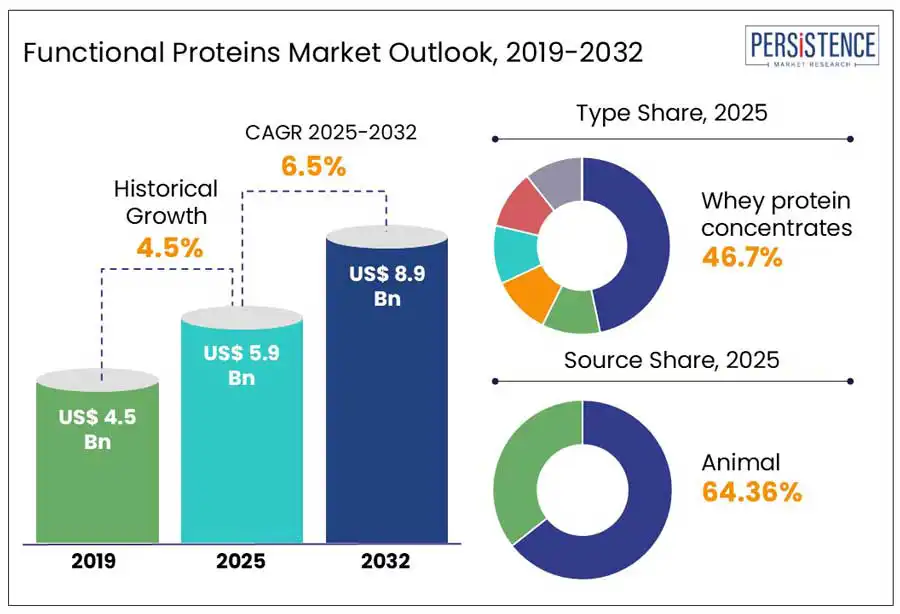Comprehensive Snapshot of Functional Proteins Market Including Regional and Country Analysis in Brief.
Industry: Food and Beverages
Published Date: April-2025
Format: PPT*, PDF, EXCEL
Delivery Timelines: Contact Sales
Number of Pages: 180
Report ID: PMRREP35196
The global functional proteins market size is estimated to grow from US$ 5.9 Bn in 2025 to US$ 8.9 Bn by 2032. The market is projected to record a CAGR of 6.2% during the forecast period from 2025 to 2032.
According to Persistence Market Research (PMR), rising consumer demand for health-focused nutrition and advancements in protein extraction technology is impacting market dynamics and creating opportunities for high-quality, sustainable, and clean-label functional protein solutions.

Key Industry Highlights:
|
Global Market Attribute |
Key Insights |
|
Functional Proteins Market Size (2025E) |
US$ 5.9 Bn |
|
Market Value Forecast (2032F) |
US$ 8.9 Bn |
|
Projected Growth (CAGR 2025 to 2032) |
6.2% |
|
Historical Market Growth (CAGR 2019 to 2024) |
4.5% |
Consumers are becoming aware of significance of nutrition in preventing chronic illnesses and improving general well-being. According to the FDA (2024), chronic diseases (CCDs), such as heart disease, diabetes, and cancer, account for 7 of the top 10 cause of deaths in the U.S., many of which are associated with unhealthy diets. Functional proteins include whey, plant-based, and hydrolyzed proteins provide vital amino acids that help with muscle maintenance, weight control, and immunity support, making them a vital element of preventative healthcare.
According to the European Union Statistics, over 67.9% of EU citizens rated their health as very excellent or good in 2023, indicating a high emphasis on preventative treatment. This trend is fueling demand for functional proteins in dietary supplements, sports nutrition, and functional food, as consumers emphasize high-quality protein sources for good health.
Functional proteins need complex processing techniques, specific extraction processes, and stringent quality control procedures. These variables greatly increase production costs, making the finished goods more expensive than traditional protein sources such as soy, rice, or basic dairy proteins.
In emerging economies with low disposable incomes, customers emphasize price above quality nutrition items. Price-sensitive countries such as Latin America and Africa frequently encounter accessibility issues, as the high cost of functional proteins makes them unaffordable to a high percentage of the population. Furthermore, tariffs on imports, supply chain inefficiencies, and fluctuating currencies hike prices in these regions, restricting the supply of functional protein-based food and supplements.
As consumers become more health conscious, there is an increasing need for chemical-free, naturally obtained functional proteins. This shift is driven by concerns over artificial additives, GMOs, and extensive processing methods in protein production. Companies that encourage clean-label, natural, and sustainably produced functional proteins have enormous opportunities to further expand their market share.
Vivici, a Netherlands-based company, launched its nature-identical whey protein. Vivici uses precise fermentation to manufacture animal-free whey protein that has the qualities of regular dairy protein without relying on livestock farming. The product has self-certified GRAS (Generally Recognized as Safe) certification in the U.S. allowing it to enter the functional proteins market as a safe and sustainable option.
As the demand for plant-based proteins , non-GMO, and clean-label proteins grows, companies who invest in natural protein innovation and sustainable production methods will gain a competitive advantage. Offering minimally processed, eco-friendly functional proteins meets customer expectations and gives companies a strategic advantage in the growing protein market.
Whey protein concentrates (WPC) hold a prominent share in the functional proteins market due to their high nutritional value, cost-effectiveness, and versatility in various applications. WPC contains vital amino acids, making it ideal for sports nutrition, functional food, and nutritional supplements. WPC's outstanding solubility and functional qualities make it a popular ingredient in protein powders, RTD beverages, dairy products, and bread compositions.
Compared to whey protein isolates and hydrolysates, WPC contains more bioactive components and has a balanced protein-to-fat ratio, making it best suited to a wider range of consumers. The growing demand for high-protein diets, fueled by health-conscious consumers and exercise fanatics, has greatly increased WPC usage. Additionally, the growing awareness of muscle recovery, weight management, and overall wellness has led to increased consumption of whey-based protein products.
Animal-based proteins dominate the functional protein industry because of their better nutritional profile, high bioavailability, and wide range of applications. Animal-derived proteins, such as whey, casein, collagen, and egg proteins, have complete amino acid profiles, making them ideal for muscle growth, recovery, and overall health. Whey protein, in particular, is well known for its rapid absorption rate and high leucine concentration, making it the favored ingredient in sports nutrition and nutritional supplements.
Furthermore, animal-based proteins are commonly used in medical nutrition and infant formula due to their proven efficacy in muscle maintenance, weight management, and immune function. These proteins also have superior texture, solubility, and taste, making them easier to incorporate into a variety of functional food and beverage applications.

Persistence Market Research (PMR) analysis finds that the U.S. continues to dominate the North American functional proteins market due to the advancements in the food and beverage industry, strong consumer demand for health-focused products, and extensive research and development capabilities.
The U.S. has a robust protein processing industry, with major companies such as Glanbia, ADM, and Cargill with leading advancements in functional protein formulations. Growing customer awareness of the health advantages of functional proteins and the increasing adoption of protein-enriched foods and drinks contributes to its success.
South Asia Oceania is projected to experience a CAGR of 7.4% during the forecast period according to Persistence Market Research. Growing fitness trends, sports nutrition consumption, and the use of plant-based and dairy proteins are contributing to the rise in demand for functional protein products in countries such as India, Australia, and New Zealand. Furthermore, the food and beverage sector in these areas is evolving quickly as companies are launching novel protein-enriched products to satisfy consumer needs.
The global functional proteins market is fragmented and competitive as food companies are actively investing in plant-based protein alternatives to meet growing consumer demand for sustainable and health-conscious options. Companies are investing extensively in research and development to develop advanced protein formulations that cater to increasing consumer demands.
Partnerships between ingredient suppliers and food manufacturers are becoming increasingly prevalent, allowing for elevated product development and widened market reach. Given the rising demand for high-protein products among athletes, fitness enthusiasts, and health-conscious consumers, sports nutrition continues to be a crucial area of competitiveness. Specialized protein formulas are introduced by companies to improve overall performance, endurance and muscle recovery
|
Report Attribute |
Details |
|
Historical Data/Actuals |
2019 - 2024 |
|
Forecast Period |
2025 - 2032 |
|
Market Analysis |
Value: US$ Bn Volume: Tons |
|
Geographical Coverage |
|
|
Segmental Coverage |
|
|
Competitive Analysis |
|
|
Report Highlights |
|
|
Customization and Pricing |
Available upon request |
By Type
By Source
By Application
By Region
To know more about delivery timeline for this report Contact Sales

The functional proteins market is estimated to be valued at US$ 5.9 Bn by the end of 2025.
Rising consumer demand for high-protein, nutritious, and functional food products is a key demand driver.
The North America region dominates the global Functional Proteins market.
Whey protein concentrates are the most popular and in-demand type of Functional Proteins.
Glanbia plc, ADM, Kerry Group plc, Fonterra Co-Operative Group Limited, Ingredion, Cargill, Incorporated, Arla Foods Ingredients Group P/S among others are the leading players in Functional Proteins market.